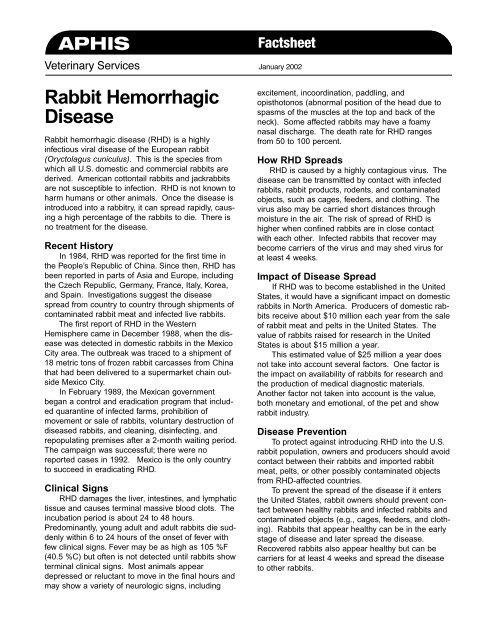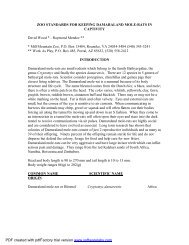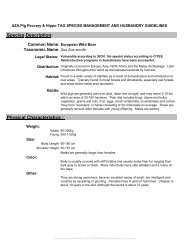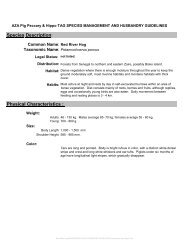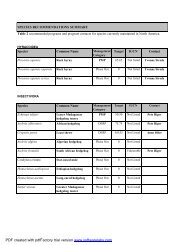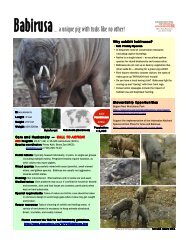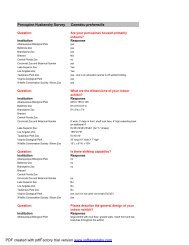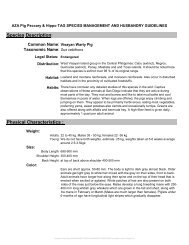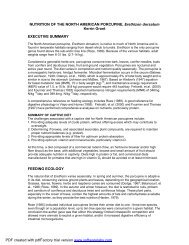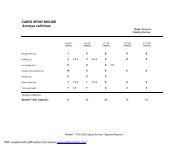APHIS Fact Sheet Rabbit Hemorrhagic Disease
APHIS Fact Sheet Rabbit Hemorrhagic Disease
APHIS Fact Sheet Rabbit Hemorrhagic Disease
You also want an ePaper? Increase the reach of your titles
YUMPU automatically turns print PDFs into web optimized ePapers that Google loves.
<strong>APHIS</strong><strong>Fact</strong>sheetVeterinary Services January 2002<strong>Rabbit</strong> <strong>Hemorrhagic</strong><strong>Disease</strong><strong>Rabbit</strong> hemorrhagic disease (RHD) is a highlyinfectious viral disease of the European rabbit(Oryctolagus cuniculus). This is the species fromwhich all U.S. domestic and commercial rabbits arederived. American cottontail rabbits and jackrabbitsare not susceptible to infection. RHD is not known toharm humans or other animals. Once the disease isintroduced into a rabbitry, it can spread rapidly, causinga high percentage of the rabbits to die. There isno treatment for the disease.Recent HistoryIn 1984, RHD was reported for the first time inthe People’s Republic of China. Since then, RHD hasbeen reported in parts of Asia and Europe, includingthe Czech Republic, Germany, France, Italy, Korea,and Spain. Investigations suggest the diseasespread from country to country through shipments ofcontaminated rabbit meat and infected live rabbits.The first report of RHD in the WesternHemisphere came in December 1988, when the diseasewas detected in domestic rabbits in the MexicoCity area. The outbreak was traced to a shipment of18 metric tons of frozen rabbit carcasses from Chinathat had been delivered to a supermarket chain outsideMexico City.In February 1989, the Mexican governmentbegan a control and eradication program that includedquarantine of infected farms, prohibition ofmovement or sale of rabbits, voluntary destruction ofdiseased rabbits, and cleaning, disinfecting, andrepopulating premises after a 2-month waiting period.The campaign was successful; there were noreported cases in 1992. Mexico is the only countryto succeed in eradicating RHD.Clinical SignsRHD damages the liver, intestines, and lymphatictissue and causes terminal massive blood clots. Theincubation period is about 24 to 48 hours.Predominantly, young adult and adult rabbits die suddenlywithin 6 to 24 hours of the onset of fever withfew clinical signs. Fever may be as high as 105 %F(40.5 %C) but often is not detected until rabbits showterminal clinical signs. Most animals appeardepressed or reluctant to move in the final hours andmay show a variety of neurologic signs, includingexcitement, incoordination, paddling, andopisthotonos (abnormal position of the head due tospasms of the muscles at the top and back of theneck). Some affected rabbits may have a foamynasal discharge. The death rate for RHD rangesfrom 50 to 100 percent.How RHD SpreadsRHD is caused by a highly contagious virus. Thedisease can be transmitted by contact with infectedrabbits, rabbit products, rodents, and contaminatedobjects, such as cages, feeders, and clothing. Thevirus also may be carried short distances throughmoisture in the air. The risk of spread of RHD ishigher when confined rabbits are in close contactwith each other. Infected rabbits that recover maybecome carriers of the virus and may shed virus forat least 4 weeks.Impact of <strong>Disease</strong> SpreadIf RHD was to become established in the UnitedStates, it would have a significant impact on domesticrabbits in North America. Producers of domestic rabbitsreceive about $10 million each year from the saleof rabbit meat and pelts in the United States. Thevalue of rabbits raised for research in the UnitedStates is about $15 million a year.This estimated value of $25 million a year doesnot take into account several factors. One factor isthe impact on availability of rabbits for research andthe production of medical diagnostic materials.Another factor not taken into account is the value,both monetary and emotional, of the pet and showrabbit industry.<strong>Disease</strong> PreventionTo protect against introducing RHD into the U.S.rabbit population, owners and producers should avoidcontact between their rabbits and imported rabbitmeat, pelts, or other possibly contaminated objectsfrom RHD-affected countries.To prevent the spread of the disease if it entersthe United States, rabbit owners should prevent contactbetween healthy rabbits and infected rabbits andcontaminated objects (e.g., cages, feeders, and clothing).<strong>Rabbit</strong>s that appear healthy can be in the earlystage of disease and later spread the disease.Recovered rabbits also appear healthy but can becarriers for at least 4 weeks and spread the diseaseto other rabbits.
Owners should be cautious and isolate newrabbits and rabbits returning from shows for at least 5days. If rabbits were exposed to RHD, isolation mayhelp prevent spread to other rabbits. Clinical diseaseusually will be noticeable within 48 hours of infection.If RHD is suspected, to prevent spread of thevirus, rabbit owners should clean and disinfect allequipment. After thorough cleaning, rabbit breedersshould use one of the following disinfectant solutionson equipment to inactivate the virus: 2-percent 1-Stroke Environ_ (Steris Corporation, St. Louis, MO),0.5-percent sodium hypochlorite, or 10-percent householdbleach.VaccineNo vaccine is legally available for use in theUnited States. Vaccine has been used in othercountries. Vaccination often reduces the number ofrabbits dying from RHD, but will not eradicate thedisease. <strong>Rabbit</strong>s vaccinated against RHD maybecome infected but not show signs of disease, therebyallowing spread of the virus as a carrier.Report Possible <strong>Disease</strong>Veterinarians and rabbit owners who suspect arabbit may have RHD should immediately contactState or Federal animal health authorities.For more information, contactU.S. Department of AgricultureAnimal and Plant Health Inspection ServiceVeterinary Services, Emergency Programs4700 River Road, Unit 41Riverdale, MD 20737–1231Telephone: (301) 734–8073Fax: (301) 734–7817The U.S. Department of Agriculture (USDA) prohibits discriminationin all its programs and activities on the basis of race, color, nationalorigin, sex, religion, age, disability, political beliefs, sexual orientation,or marital or family status. (Not all prohibited bases apply toall programs.) Persons with disabilities who require alternativemeans for communication of program information (Braille, largeprint, audiotape, etc.) should contact USDA’s TARGET Center at(202) 720–2600 (voice and TDD).To file a complaint of discrimination, write USDA, Director, Office ofCivil Rights, Room 326–W, Whitten Building, 1400 IndependenceAvenue, SW, Washington, DC 20250–9410 or call (202) 720–5964(voice and TDD). USDA is an equal opportunity provider andemployer.Mention of companies or commercial products does not implyrecommendation or endorsement by the U.S. Department ofAgriculture over others not mentioned. USDA neither guaranteesnor warrants the standard of any product mentioned. Productnames are mentioned solely to report factually on available dataand to provide specific information.United States Department of Agriculture• Animal and Plant Health Inspection Service• Safeguarding American Agriculture


